[English] 日本語
 Yorodumi
Yorodumi- PDB-4ylq: Crystal Structure of a FVIIa-Trypsin Chimera (FT) in Complex with... -
+ Open data
Open data
- Basic information
Basic information
| Entry | Database: PDB / ID: 4ylq | |||||||||
|---|---|---|---|---|---|---|---|---|---|---|
| Title | Crystal Structure of a FVIIa-Trypsin Chimera (FT) in Complex with Soluble Tissue Factor | |||||||||
 Components Components |
| |||||||||
 Keywords Keywords |  HYDROLASE / trypsin-fold / protein-protein complex HYDROLASE / trypsin-fold / protein-protein complex | |||||||||
| Function / homology |  Function and homology information Function and homology informationactivation of plasma proteins involved in acute inflammatory response / activation of blood coagulation via clotting cascade /  coagulation factor VIIa / response to Thyroid stimulating hormone / response to 2,3,7,8-tetrachlorodibenzodioxine / response to astaxanthin / response to thyrotropin-releasing hormone / response to genistein / serine-type peptidase complex / positive regulation of platelet-derived growth factor receptor signaling pathway ...activation of plasma proteins involved in acute inflammatory response / activation of blood coagulation via clotting cascade / coagulation factor VIIa / response to Thyroid stimulating hormone / response to 2,3,7,8-tetrachlorodibenzodioxine / response to astaxanthin / response to thyrotropin-releasing hormone / response to genistein / serine-type peptidase complex / positive regulation of platelet-derived growth factor receptor signaling pathway ...activation of plasma proteins involved in acute inflammatory response / activation of blood coagulation via clotting cascade /  coagulation factor VIIa / response to Thyroid stimulating hormone / response to 2,3,7,8-tetrachlorodibenzodioxine / response to astaxanthin / response to thyrotropin-releasing hormone / response to genistein / serine-type peptidase complex / positive regulation of platelet-derived growth factor receptor signaling pathway / response to vitamin K / response to carbon dioxide / response to thyroxine / positive regulation of leukocyte chemotaxis / NGF-stimulated transcription / response to cholesterol / response to growth hormone / coagulation factor VIIa / response to Thyroid stimulating hormone / response to 2,3,7,8-tetrachlorodibenzodioxine / response to astaxanthin / response to thyrotropin-releasing hormone / response to genistein / serine-type peptidase complex / positive regulation of platelet-derived growth factor receptor signaling pathway / response to vitamin K / response to carbon dioxide / response to thyroxine / positive regulation of leukocyte chemotaxis / NGF-stimulated transcription / response to cholesterol / response to growth hormone /  cytokine receptor activity / positive regulation of positive chemotaxis / Extrinsic Pathway of Fibrin Clot Formation / positive regulation of TOR signaling / positive regulation of blood coagulation / animal organ regeneration / Gamma-carboxylation of protein precursors / Transport of gamma-carboxylated protein precursors from the endoplasmic reticulum to the Golgi apparatus / Removal of aminoterminal propeptides from gamma-carboxylated proteins / positive regulation of endothelial cell proliferation / serine-type peptidase activity / BMAL1:CLOCK,NPAS2 activates circadian gene expression / positive regulation of interleukin-8 production / cytokine receptor activity / positive regulation of positive chemotaxis / Extrinsic Pathway of Fibrin Clot Formation / positive regulation of TOR signaling / positive regulation of blood coagulation / animal organ regeneration / Gamma-carboxylation of protein precursors / Transport of gamma-carboxylated protein precursors from the endoplasmic reticulum to the Golgi apparatus / Removal of aminoterminal propeptides from gamma-carboxylated proteins / positive regulation of endothelial cell proliferation / serine-type peptidase activity / BMAL1:CLOCK,NPAS2 activates circadian gene expression / positive regulation of interleukin-8 production /  phospholipid binding / protein processing / Golgi lumen / cytokine-mediated signaling pathway / phospholipid binding / protein processing / Golgi lumen / cytokine-mediated signaling pathway /  circadian rhythm / response to estrogen / activation of cysteine-type endopeptidase activity involved in apoptotic process / positive regulation of angiogenesis / circadian rhythm / response to estrogen / activation of cysteine-type endopeptidase activity involved in apoptotic process / positive regulation of angiogenesis /  blood coagulation / response to estradiol / collagen-containing extracellular matrix / blood coagulation / response to estradiol / collagen-containing extracellular matrix /  protease binding / vesicle / response to hypoxia / positive regulation of cell migration / external side of plasma membrane / protease binding / vesicle / response to hypoxia / positive regulation of cell migration / external side of plasma membrane /  endoplasmic reticulum lumen / endoplasmic reticulum lumen /  signaling receptor binding / serine-type endopeptidase activity / signaling receptor binding / serine-type endopeptidase activity /  calcium ion binding / positive regulation of gene expression / calcium ion binding / positive regulation of gene expression /  cell surface / cell surface /  extracellular space / extracellular region / extracellular space / extracellular region /  membrane / membrane /  plasma membrane plasma membraneSimilarity search - Function | |||||||||
| Biological species |   Homo sapiens (human) Homo sapiens (human) | |||||||||
| Method |  X-RAY DIFFRACTION / X-RAY DIFFRACTION /  SYNCHROTRON / SYNCHROTRON /  MOLECULAR REPLACEMENT / MOLECULAR REPLACEMENT /  molecular replacement / Resolution: 1.4 Å molecular replacement / Resolution: 1.4 Å | |||||||||
| Model details | A human-FVIIa Variant with the 170-loop swapped with that from human-Trypsin, and an additional ...A human-FVIIa Variant with the 170-loop swapped with that from human-Trypsin, and an additional replacement of Tyr170b with Phe | |||||||||
 Authors Authors | Sorensen, A.B. / Svensson, L.A. / Gandhi, P.S. | |||||||||
 Citation Citation |  Journal: J.Biol.Chem. / Year: 2016 Journal: J.Biol.Chem. / Year: 2016Title: Molecular Basis of Enhanced Activity in Factor VIIa-Trypsin Variants Conveys Insights into Tissue Factor-mediated Allosteric Regulation of Factor VIIa Activity. Authors: Sorensen, A.B. / Madsen, J.J. / Svensson, L.A. / Pedersen, A.A. / stergaard, H. / Overgaard, M.T. / Olsen, O.H. / Gandhi, P.S. | |||||||||
| History |
|
- Structure visualization
Structure visualization
| Structure viewer | Molecule:  Molmil Molmil Jmol/JSmol Jmol/JSmol |
|---|
- Downloads & links
Downloads & links
- Download
Download
| PDBx/mmCIF format |  4ylq.cif.gz 4ylq.cif.gz | 386.4 KB | Display |  PDBx/mmCIF format PDBx/mmCIF format |
|---|---|---|---|---|
| PDB format |  pdb4ylq.ent.gz pdb4ylq.ent.gz | 317 KB | Display |  PDB format PDB format |
| PDBx/mmJSON format |  4ylq.json.gz 4ylq.json.gz | Tree view |  PDBx/mmJSON format PDBx/mmJSON format | |
| Others |  Other downloads Other downloads |
-Validation report
| Arichive directory |  https://data.pdbj.org/pub/pdb/validation_reports/yl/4ylq https://data.pdbj.org/pub/pdb/validation_reports/yl/4ylq ftp://data.pdbj.org/pub/pdb/validation_reports/yl/4ylq ftp://data.pdbj.org/pub/pdb/validation_reports/yl/4ylq | HTTPS FTP |
|---|
-Related structure data
| Related structure data |  4z6aC  4zmaC 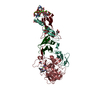 1danS C: citing same article ( S: Starting model for refinement |
|---|---|
| Similar structure data |
- Links
Links
- Assembly
Assembly
| Deposited unit | 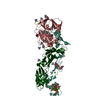
| ||||||||
|---|---|---|---|---|---|---|---|---|---|
| 1 |
| ||||||||
| Unit cell |
|
- Components
Components
-Coagulation factor ... , 2 types, 2 molecules LH
| #1: Protein |  / Proconvertin / Serum prothrombin conversion accelerator / SPCA / Proconvertin / Serum prothrombin conversion accelerator / SPCAMass: 17487.076 Da / Num. of mol.: 1 Fragment: BLOOD COAGULATION FACTOR VIIA LIGHT CHAIN, UNP residues 61-212 Source method: isolated from a genetically manipulated source Source: (gene. exp.)   Homo sapiens (human) / Tissue: Blood Homo sapiens (human) / Tissue: Blood / Gene: F7 / Organ: Kidney / Gene: F7 / Organ: Kidney / Plasmid: pQMCF-5 / Plasmid: pQMCF-5Details (production host): Cells were licensed from Icosagen (Estonia) Cell line (production host): CHOEBNALT85 / Production host:   Cricetulus griseus (Chinese hamster) / References: UniProt: P08709, Cricetulus griseus (Chinese hamster) / References: UniProt: P08709,  coagulation factor VIIa coagulation factor VIIa |
|---|---|
| #2: Protein |  / Proconvertin / Serum prothrombin conversion accelerator / SPCA / Proconvertin / Serum prothrombin conversion accelerator / SPCAMass: 27508.611 Da / Num. of mol.: 1 / Fragment: UNP residues 213-466 / Mutation: [169-175] LQQSRKVGDSPN - EASFPGK Source method: isolated from a genetically manipulated source Source: (gene. exp.)   Homo sapiens (human) / Tissue: Blood Homo sapiens (human) / Tissue: Blood / Gene: F7 / Organ: Kidney / Gene: F7 / Organ: Kidney / Plasmid: pQMCF-5 / Plasmid: pQMCF-5Details (production host): Cells were licensed from Icosagen (Estonia) Cell line (production host): CHOEBNALT85 / Production host:   Cricetulus griseus (Chinese hamster) / References: UniProt: P08709, Cricetulus griseus (Chinese hamster) / References: UniProt: P08709,  coagulation factor VIIa coagulation factor VIIa |
-Protein , 1 types, 1 molecules T
| #3: Protein |  / TF / Coagulation factor III / Thromboplastin / TF / Coagulation factor III / ThromboplastinMass: 24826.512 Da / Num. of mol.: 1 / Fragment: UNP residues 33-251 Source method: isolated from a genetically manipulated source Source: (gene. exp.)   Homo sapiens (human) / Tissue: Blood Homo sapiens (human) / Tissue: Blood / Gene: F3 / Plasmid: pET3a / Production host: / Gene: F3 / Plasmid: pET3a / Production host:   Escherichia coli BL21(DE3) (bacteria) / Variant (production host): Origami 2 / References: UniProt: P13726 Escherichia coli BL21(DE3) (bacteria) / Variant (production host): Origami 2 / References: UniProt: P13726 |
|---|
-Sugars , 2 types, 2 molecules 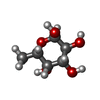
| #4: Polysaccharide | alpha-D-xylopyranose-(1-3)-alpha-D-xylopyranose-(1-3)-beta-D-glucopyranose / Mass: 444.386 Da / Num. of mol.: 1 / Mass: 444.386 Da / Num. of mol.: 1Source method: isolated from a genetically manipulated source |
|---|---|
| #6: Sugar | ChemComp-FUC /  Fucose Fucose |
-Non-polymers , 5 types, 608 molecules 








| #5: Chemical | ChemComp-CA / #7: Chemical | ChemComp-TMA /  Tetramethylammonium Tetramethylammonium#8: Chemical | ChemComp-0Z7 / |   Mass: 546.081 Da / Num. of mol.: 1 / Fragment: UNP residues 213-466 / Mutation: [169-175] LQQSRKVGDSPN - EASFPGK Mass: 546.081 Da / Num. of mol.: 1 / Fragment: UNP residues 213-466 / Mutation: [169-175] LQQSRKVGDSPN - EASFPGKSource method: isolated from a genetically manipulated source Formula: C27H38ClN6O4 / Source: (gene. exp.)   Homo sapiens (human) / Tissue: Blood Homo sapiens (human) / Tissue: Blood / Gene: F7 / Organ: Kidney / Gene: F7 / Organ: Kidney / Plasmid: pQMCF-5 / Plasmid: pQMCF-5Details (production host): Cells were licensed from Icosagen (Estonia) Cell line (production host): CHOEBNALT85 / Production host:   Cricetulus griseus (Chinese hamster) / References: Cricetulus griseus (Chinese hamster) / References:  coagulation factor VIIa coagulation factor VIIa#9: Chemical | ChemComp-POL / |  Propan-1-ol Propan-1-ol#10: Water | ChemComp-HOH / |  Water Water |
|---|
-Experimental details
-Experiment
| Experiment | Method:  X-RAY DIFFRACTION / Number of used crystals: 1 X-RAY DIFFRACTION / Number of used crystals: 1 |
|---|
- Sample preparation
Sample preparation
| Crystal | Density Matthews: 2.52 Å3/Da / Density % sol: 51.23 % / Description: Elongated hexgonal prisms |
|---|---|
Crystal grow | Temperature: 295 K / Method: vapor diffusion, hanging drop / pH: 5.6 Details: 0.1M NaCitrate, 16.6% PEG 3350, 12.5% 1-Propanol, with seeding |
-Data collection
| Diffraction | Mean temperature: 100 K | ||||||||||||||||||||||||||||||||||||||||||||||||||||||||||||||||||||||||||||||||||||||||||||||||||||||||||||||||||||||||||||||||||||
|---|---|---|---|---|---|---|---|---|---|---|---|---|---|---|---|---|---|---|---|---|---|---|---|---|---|---|---|---|---|---|---|---|---|---|---|---|---|---|---|---|---|---|---|---|---|---|---|---|---|---|---|---|---|---|---|---|---|---|---|---|---|---|---|---|---|---|---|---|---|---|---|---|---|---|---|---|---|---|---|---|---|---|---|---|---|---|---|---|---|---|---|---|---|---|---|---|---|---|---|---|---|---|---|---|---|---|---|---|---|---|---|---|---|---|---|---|---|---|---|---|---|---|---|---|---|---|---|---|---|---|---|---|---|
| Diffraction source | Source:  SYNCHROTRON / Site: SYNCHROTRON / Site:  MAX II MAX II  / Beamline: I911-3 / Wavelength: 1 Å / Beamline: I911-3 / Wavelength: 1 Å | ||||||||||||||||||||||||||||||||||||||||||||||||||||||||||||||||||||||||||||||||||||||||||||||||||||||||||||||||||||||||||||||||||||
| Detector | Type: MARMOSAIC 225 mm CCD / Detector: CCD / Date: Jun 18, 2014 Details: Rh-coated Si mirrors: M1 collimating mirror, M2 toroidal focusing mirror | ||||||||||||||||||||||||||||||||||||||||||||||||||||||||||||||||||||||||||||||||||||||||||||||||||||||||||||||||||||||||||||||||||||
| Radiation | Monochromator: Si (111) / Protocol: SINGLE WAVELENGTH / Monochromatic (M) / Laue (L): M / Scattering type: x-ray | ||||||||||||||||||||||||||||||||||||||||||||||||||||||||||||||||||||||||||||||||||||||||||||||||||||||||||||||||||||||||||||||||||||
| Radiation wavelength | Wavelength : 1 Å / Relative weight: 1 : 1 Å / Relative weight: 1 | ||||||||||||||||||||||||||||||||||||||||||||||||||||||||||||||||||||||||||||||||||||||||||||||||||||||||||||||||||||||||||||||||||||
| Reflection | Resolution: 1.4→33.57 Å / Num. all: 138932 / Num. obs: 138932 / % possible obs: 100 % / Observed criterion σ(I): -3 / Redundancy: 7.3 % / Biso Wilson estimate: 15.27 Å2 / Rmerge F obs: 0.999 / Rmerge(I) obs: 0.094 / Rrim(I) all: 0.101 / Χ2: 1.007 / Net I/σ(I): 14.07 / Num. measured all: 1011012 | ||||||||||||||||||||||||||||||||||||||||||||||||||||||||||||||||||||||||||||||||||||||||||||||||||||||||||||||||||||||||||||||||||||
| Reflection shell | Diffraction-ID: 1 / Rejects: 0
|
-Phasing
Phasing | Method:  molecular replacement molecular replacement | |||||||||
|---|---|---|---|---|---|---|---|---|---|---|
| Phasing MR |
|
- Processing
Processing
| Software |
| |||||||||||||||||||||||||||||||||||||||||||||||||||||||||||||||||||||||||||||||||||||||||||||||||||||||||||||||||||||||||||||||||||||||||||||||||||||||||||||||||||||||||||||||||||||||||||||||||||||||||||||||||||||||||
|---|---|---|---|---|---|---|---|---|---|---|---|---|---|---|---|---|---|---|---|---|---|---|---|---|---|---|---|---|---|---|---|---|---|---|---|---|---|---|---|---|---|---|---|---|---|---|---|---|---|---|---|---|---|---|---|---|---|---|---|---|---|---|---|---|---|---|---|---|---|---|---|---|---|---|---|---|---|---|---|---|---|---|---|---|---|---|---|---|---|---|---|---|---|---|---|---|---|---|---|---|---|---|---|---|---|---|---|---|---|---|---|---|---|---|---|---|---|---|---|---|---|---|---|---|---|---|---|---|---|---|---|---|---|---|---|---|---|---|---|---|---|---|---|---|---|---|---|---|---|---|---|---|---|---|---|---|---|---|---|---|---|---|---|---|---|---|---|---|---|---|---|---|---|---|---|---|---|---|---|---|---|---|---|---|---|---|---|---|---|---|---|---|---|---|---|---|---|---|---|---|---|---|---|---|---|---|---|---|---|---|---|---|---|---|---|---|---|---|
| Refinement | Method to determine structure : :  MOLECULAR REPLACEMENT MOLECULAR REPLACEMENTStarting model: In-House FVIIa-WT:sTF-FFR similar to 1DAN Resolution: 1.4→34.253 Å / SU ML: 0.17 / Cross valid method: FREE R-VALUE / σ(F): 1.34 / Phase error: 18.31 / Stereochemistry target values: ML
| |||||||||||||||||||||||||||||||||||||||||||||||||||||||||||||||||||||||||||||||||||||||||||||||||||||||||||||||||||||||||||||||||||||||||||||||||||||||||||||||||||||||||||||||||||||||||||||||||||||||||||||||||||||||||
| Solvent computation | Shrinkage radii: 0.9 Å / VDW probe radii: 1.11 Å / Solvent model: FLAT BULK SOLVENT MODEL | |||||||||||||||||||||||||||||||||||||||||||||||||||||||||||||||||||||||||||||||||||||||||||||||||||||||||||||||||||||||||||||||||||||||||||||||||||||||||||||||||||||||||||||||||||||||||||||||||||||||||||||||||||||||||
| Displacement parameters | Biso max: 84.64 Å2 / Biso mean: 26.4558 Å2 / Biso min: 7.7 Å2 | |||||||||||||||||||||||||||||||||||||||||||||||||||||||||||||||||||||||||||||||||||||||||||||||||||||||||||||||||||||||||||||||||||||||||||||||||||||||||||||||||||||||||||||||||||||||||||||||||||||||||||||||||||||||||
| Refinement step | Cycle: final / Resolution: 1.4→34.253 Å
| |||||||||||||||||||||||||||||||||||||||||||||||||||||||||||||||||||||||||||||||||||||||||||||||||||||||||||||||||||||||||||||||||||||||||||||||||||||||||||||||||||||||||||||||||||||||||||||||||||||||||||||||||||||||||
| Refine LS restraints |
| |||||||||||||||||||||||||||||||||||||||||||||||||||||||||||||||||||||||||||||||||||||||||||||||||||||||||||||||||||||||||||||||||||||||||||||||||||||||||||||||||||||||||||||||||||||||||||||||||||||||||||||||||||||||||
| LS refinement shell | Refine-ID: X-RAY DIFFRACTION / Total num. of bins used: 30
|
 Movie
Movie Controller
Controller


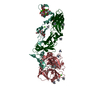
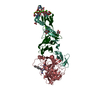

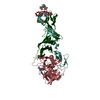

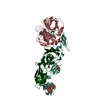

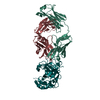
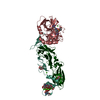

 PDBj
PDBj












